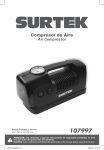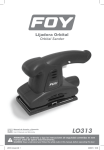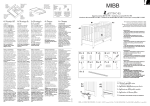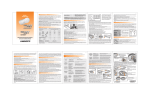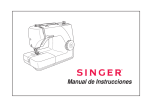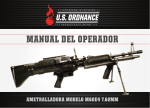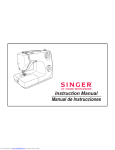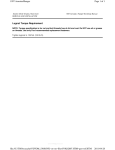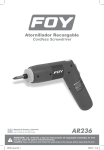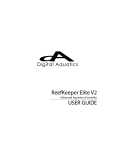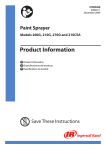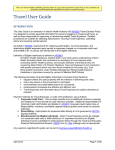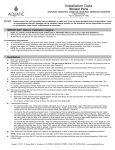Download Lijadora Neumática Orbital
Transcript
Lijadora Neumática Orbital Orbital Jitterbug Air Sander Manual de Usuario y Garantía. User’s Manual and Warranty. UP766 ATENCIÓN: Lea, entienda y siga las instrucciones de seguridad contenidas en este manual, antes de operar esta herramienta. WARNING: Read, understand and follow the safety rules in this manual, before operating this tool. UP766 manual.indd 1 10/06/15 9:32 INTRODUCCIÓN Esta herramienta neumática ha sido diseñada para ser utilizada con lijas y abrasivos adecuados para lijar metales, maderas, piedras, plásticos y otros materiales. Sólo debe ser utilizada para tales aplicaciones de lijado y dentro de sus grados y capacidades marcados. Se deben utilizar con esta herramienta sólo los accesorios específicamente recomendados por el distribuidor. Si se utilizara de cualquier otra manera o con otros accesorios, podría crear condiciones de funcionamiento inseguras. No haga funcionar la herramienta en el agua o en aplicaciones extremadamente húmedas. La exposición al POLVO originado por la pieza de trabajo y materiales abrasivos puede afectar los pulmones o producir otra lesión física. Utilice el escape de aire local o extracción de polvo adecuados según las indicaciones de seguridad. Use los elementos de protección aprobados y protéjase los ojos y la piel. El no respetar esta advertencia puede ocasionar daños en los pulmones y/o lesiones físicas. ADVERTENCIAS DE SEGURIDAD PARA HERRAMIENTAS NEUMÁTICAS Para reducir los riesgos de todos los peligros asociados con este producto: • Lea, comprenda y siga toda la información de seguridad contenida en estas instrucciones antes de utilizar esta herramienta. • Sólo el personal debidamente capacitado puede realizar el servicio a esta herramienta. • Siempre utilice protección ocular, auditiva y respiratoria mientras opere este producto. Siga las normas locales y nacionales para las gafas de protección y otros requisitos sobre los equipos de protección personal. Requisitos de las prácticas de seguridad. Trabaje alerta. Use la indumentaria adecuada. Nunca opere herramientas bajo los efectos del alcohol o drogas de una manera inconsistente con su uso específico. Para reducir los peligros asociados con la ruptura o desintegración de los accesorios: • Nunca exceda la presión de entrada máxima marcada a 90 PSI. • Sea cuidadoso al sujetar la máquina; siga las instrucciones para asegurarse de que la lija quede bien sujeta a la herramienta antes de utilizarla. Para reducir los riesgos asociados con los ruidos fuertes: • Inmediatamente detenga el uso del producto si el silenciador para la reducción del ruido se hubiera dañado o si no funcionara correctamente. Haga reparar el producto antes de ponerlo en uso nuevamente. Para reducir los riesgos asociados con las emisiones de vibraciones durante el uso: • Si llegara a experimentar cualquier incomodidad física en manos/muñecas, deje de trabajar rápidamente y busque atención médica. Las lesiones en las manos, muñecas y brazos pueden ser causadas por movimientos y trabajos repetitivos y por la sobreexposición a la vibración. Para reducir los riesgos asociados con los choques eléctricos: • No permita que esta herramienta haga contacto con fuentes de suministro eléctrico ya que la herramienta no está aislada contra las descargas eléctricas. • No haga funcionar la herramienta en o cerca de materiales explosivos, tales como líquidos inflamables, gases o polvo excesivo en el aire. La herramienta/los abrasivos pueden crear chispas al trabajar con ciertos materiales, pudiendo causar la ignición de los polvos o gases volátiles. PRECAUCIÓN Para reducir los riesgos asociados con la presión neumática y otros peligros mecánicos: • Mantenga las manos, cabello y ropa lejos del extremo en funcionamiento de la herramienta. • Nunca opere esta herramienta sin todas las protecciones o características de seguridad con respecto al orden y al perfecto estado de funcionamiento. • Tenga presente que las mangueras y los accesorios indebidamente instalados pueden aflojarse inesperadamente y en cualquier momento, creando así un peligro de impacto/latigazo. • Si nota cualquier ruido o vibración anormal al operar este producto, detenga su uso inme- 2 UP766 manual.indd 2 10/06/15 9:32 E S P A Ñ O L • Ma n u a l diatamente e inspeccione la lija para ver si se encuentra gastada o dañada. Reemplace las partes dañadas. Si aun percibiera ruidos o vibraciones anormales, devuelva el producto al fabricante para que lo repare o realice un servicio. Lea las instrucciones de la garantía. INSTRUCCIONES DE OPERACIÓN PREVIO AL FUNCIONAMIENTO La herramienta ha sido diseñada para funcionar manualmente. Siempre se recomienda que, mientras se esté utilizando la herramienta, los operadores permanezcan de pie sobre un piso sólido, en una posición segura con un agarre y una base firmes. Tenga en cuenta que la lijadora puede ocasionar una reacción de torque. Vea la sección de “ADVERTENCIAS DE SEGURIDAD”. Utilice un suministro de aire limpio y lubricado que provea a la herramienta una presión medida de aproximadamente 90 PSI cuando la herramienta se encuentre funcionando con la palanca totalmente presionada. Se recomienda utilizar una línea de aire aprobada de 10 mm (3/8 pulgadas) x 8 m (25 pies) de longitud máxima. No conecte la herramienta al sistema de aire sin una válvula que cierre fácilmente el aire. Se recomienda utilizar un filtro, regulador y lubricador de aire, ya que este mismo brindará aire limpio y lubricado en la presión correcta a la herramienta. Cuando la presión de suministro exceda el máximo marcado de la herramienta en cualquiera de los casos, se utilizarán en todo momento reguladores de presión de aire adecuados mientras la herramienta esté en funcionamiento. Se pueden obtener detalles de tal equipo a partir de su distribuidor de herramientas. Si no se utilizara tal equipo, la herramienta deberá ser lubricada manualmente. Para lubricar manualmente la herramienta, desconecte la línea de aire y coloque de 2 a 3 gotas del aceite lubricante adecuado para motores neumáticos dentro del extremo de la manguera (entrada de aire) de la herramienta. Reconecte la herramienta al suministro de aire y haga funcionar la herramienta muy lentamente durante algunos segundos para permitir que el aire haga circular el aceite. Si se utilizara la herramienta con frecuencia, lubríquela diariamente o lubrí- d e U su a ri o quela si la herramienta comenzara a disminuir su intensidad o a perder fuerza. Se recomienda que la presión del aire en la herramienta sea de 90 PSI mientras que la herramienta esté funcionando para que no se exceda el máximo de revoluciones por minuto. Se puede hacer funcionar la herramienta a menor presión pero nunca a más de 90 PSI. Si funcionara con una presión más baja, el rendimiento de la herramienta disminuiría PRECAUCIONES ADICIONALES DE SEGURIDAD 1. Lea todas las instrucciones antes de utilizar la herramienta. Todos los operadores deben estar ampliamente capacitados para usarla y ser conscientes de estas medidas de seguridad. 2. Asegúrese de que la herramienta esté desconectada al suministro de aire. Elija un abrasivo apropiado y asegúrelo a la base de la lija con las pinzas de sujeción. 3. Siempre use el equipo de seguridad requerido al utilizar esta herramienta. 4. Cuando esté lijando siempre encienda la herramienta sobre la pieza de trabajo. Esto evitará que se produzcan abolladuras debido al exceso de velocidad del abrasivo. Detenga el flujo de aire hacia la herramienta a medida que se retira de la pieza de trabajo. 5. Siempre retire el suministro de aire de la lijadora antes de colocar, ajustar o retirar una lija. 6. Siempre permanezca de pie con un agarre y una base firmes y preste atención a la reacción de torque que desarrolla la lijadora. 7. Siempre asegúrese de que el material que está lijando esté sujetado con firmeza para evitar que se mueva. 8. Revise la manguera y los accesorios regularmente para detectar si hay desgaste. No mueva la herramienta sosteniéndola de la manguera; siempre tenga cuidado de evitar que la herramienta se encienda cuando la traslada con el suministro de aire conectado. 9. No exceda el máximo de presión de aire recomendado. Utilice un equipo de seguridad según se recomienda. 10. Antes de instalar cualquier accesorio abrasivo, siempre verifique la velocidad máxima requerida impresa en el accesorio sea igual o mayor a la indicada en el producto. 3 UP766 manual.indd 3 10/06/15 9:32 11. La herramienta no está aislada eléctricamente. No la utilice donde haya posibilidades de contacto con corriente eléctrica, cañerías de gas y/o cañerías de agua. 12. Mantenga las manos alejadas de la operación mientras este se encuentre en funcionamiento. 13. Si la herramienta pareciera estar funcionando mal, deje de usarla de inmediato y llévela a reparar. 14. No permita que la lijadora esté en operación sin tomar precauciones previas de seguridad para cualquier persona u objetos que estén expuestos a los residuos que se puedan desprender. 15. Suelte de inmediato la palanca de encendido en caso de que se produzca una alteración de la presión; no intente volver a encenderla hasta que se haya corregido la alteración. mangueras de un latigazo en caso de que falle o de que se desconecte. INSTALANDO LA LIJA · Voltee la lijadora. · Posicione la lija alineandola con la base de la lijadora, doble las partes de la lija que utilizará para sujetarla a la lijadora un aproximado de 90˚, y vuelva a hacer otro dobléz envolviendo la base. · Coloque una de las partes dobladas insertando en una de las pinzas de sujeción de la base, a continuación realice lo mismo del otro lado. PRECAUCIÓN: El papel lija debe encontrarse bien instalado en la base de la lijadora. Una lija mal colocada, causará un lijado irregular o daño en la misma lija. NOTA: La abertura de los agujeros de extracción de polvo en la hoja de lija y los agujeros de superficie de lijado deben mantenerse alineados. LUBRICACIÓN Las partes que se muestran en el ensamble de un buen funcionamiento de su herramienta neumática (pag.7) se identifican de la siguiente manera: 1. Filtro de aire. 2. Regulador. 3. Lubricador. 4. Válvula de paso. 5. Diámetro de la manguera. 6. Tamaño de entrada de aire. 7. Válvula de corredera. 8. Cople de seguridad. 9. Aceite. 10. Grasa (Durante el montaje). CONEXIÓN AL SUMINISTRO DE AIRE Diseñe la línea de suministro de aire para asegurar la máxima presión de funcionamiento en la entrada de aire de la herramienta. Vacíe el condensado de las válvulas en los puntos inferiores de la tubería, filtro de aire y depósito del compresor de forma diaria. Instale un cople de seguridad (válvula de corredera) y utilice un dispositivo de retención de manguera y coples en cualquier unión de manguera sin apagador interno para evitar que la MANTENIMIENTO La frecuencia de mantenimiento debe de ser de acuerdo a como se muestra en la ilustración de la pagina 7. PIEZAS Y MANTENIMIENTO La reparación y mantenimiento de esta herramienta sólo puede ser llevado a cabo por un Centro de servicio autorizado y su personal calificado. Una vez que la vida útil de herramienta se termine, se recomienda desarmar la herramienta, desengrasarla y separar las piezas de acuerdo con el material del que están fabricadas para su reciclado. ESPECIFICACIONES TÉCNICAS CAPACIDAD DE LIJA 9,3 cm x 16,5 cm VELOCIDAD AL VACÍO 8 000 r/min PESO 1,8 kg (4 lb) CONSUMO DE AIRE 4 cfm ENTRADA DE AIRE 1/4 NPT DIÁMETRO DE MANGUERA 3/8" (10 mm) PRESIÓN RECOMENDADA 90 PSI 4 UP766 manual.indd 4 10/06/15 9:32 E N G L I S H • U se r' s INTRODUCTION This pneumatic tool is designed to be used with an appropriate abrasive for sanding metals, wood, stone, plastics and other materials. It should only be used for such sanding applications and within its marked capacity and ratings. Only accessories specifically recommended by manufacturer should be used with this tool. Use in any other manner or with other accessories could lead to unsafe operating conditions. Do not operate tool in water or in an excessively wet application. Exposure to DUST generated from workpiece and/or abrasive materials can result in lung damage and/or other physical injury. Use dust capture or local exhaust as stated in the safety information sheet. Wear governmentapproved respiratory protection and eye and skin protection. Failure to follow this warning can result in serious lung damage and/or physical injury. SAFETY RULES FOR PNEUMATIC TOOLS To reduce the risk of all hazards associated with this product: • Read, understand and follow the safety information contained in these instructions prior to the use of this tool. • Only personnel who are properly trained should be allowed to service this tool. • Always wear protection for eyes, ears and respiratory protection while operating this product. Follow local / national standards for eyewear and other personal protective equipment requirements. • Practice safety requirements. Work alert, wear proper attire; never operate tools under the infl uence of alcohol or drugs or in a manner inconsistent with its intended use. To reduce the risks associated with accessory rupture or disintegration: • Never exceed marked maximum input pressure of 90 PSI. • Use care in attaching sandpapers; follow the instructions to ensure that it is securely attached to the tool before use. • Never point this product in the direction of yourself or another person. ma n u a l To reduce the risk associated with loud noise: • Immediately discontinue use of product if its noise reduction muffler system has been damaged or is otherwise not functioning properly. Have product repaired before placing back into use. To reduce the risk associated with vibration emissions during use of product: • If any physical hand/wrist discomfort is experienced, stop work promptly and seek medical attention. Hand, wrist and arm injury may result from repetitive work, motion and over exposure to vibration. To reduce the risk associated with electrical shock and/or explosion: • Do not allow this tool to contact electrical power sources as the tool is not insulated against electrical shock. • Do not operate the tool in or near explosive materials, such as flammable liquids, gases or excessive airborne dust. The tool/abrasives can create sparks when working material, resulting in the ignition of the flammable dust or fumes. CAUTION To reduce the risk associated with pneumatic pressure and other mechanical hazards: • Keep hands, hair and clothing away from the working end of the tool. • Never operate this tool without all guards or safety features in place and in proper working order. • Be aware that incorrectly installed hoses and fittings might unexpectedly come loose at any time and create a whipping/impact hazard. • If you notice any abnormal noise or vibration when operating the product, immediately discontinue its use and inspect for worn or damaged backup sandpapers. Replace any damaged parts. If abnormal noise or vibration still exists, return to the manufacturer for service or repair. Refer to warranty instructions. OPERATING INSTRUCTIONS PRIOR TO THE OPERATION The tool is intended to be operated as a hand held tool. It is always recommended that while using the tool, operators stand on a solid floor, 5 UP766 manual.indd 5 10/06/15 9:32 in a secure position with a firm grip and footing. Be aware that the sander can develop a torque reaction. See the section “SAFETY PRECAUTIONS”. Use a clean lubricated air supply that will give a measured air pressure at the tool of 90 PSI when the tool is running with the lever fully depressed. It is recommended to use an approved 10 mm (3/8”) x 8m (25ft) maximum length airline. Do not connect the tool to the airline system without an easily accessible air shut off valve. It is strongly recommended that an air filter, regulator and lubricator (FRL) be used as this will supply clean, lubricated air at the correct pressure to the tool. In any case appropriate air pressure regulators shall be used at all times while operating this tool where the supply pressure exceeds the marked maximum of the tool. Details of such equipment can be obtained for your tool distributor. If such equipment is not used, the tool should be manually lubricated. To manually lubricate the tool, disconnect the airline and put 2 to 3 drops of suitable pneumatic motor lubricating oil into the hose end (inlet) of the tool. Reconnect tool to the air supply and run tool slowly for a few seconds to allow air to circulate the oil. If the tool is used frequently, lubricate it on a daily basis or lubricate it if the tool starts to slow or lose power. It is recommended that the air pressure at the tool be 90 PSI while the tool is running so the maximum RPM is not exceeded. The tool can be run at lower pressures but should never be run higher than 90 PSI. If run at lower pressure the performance of the tool is reduced. SAFETY PRECAUTIONS 1. Read all instructions before using this tool. All operators must be fully trained in its use and aware of these safety rules. 2. Make sure the tool is disconnected from the air supply. Select a suitable abrasive and secure it to sander. 3. Always wear required safety equipment when using this tool. 4. When sanding, always start the tool on the workpiece. This will prevent gouging due to excess speed of the abrasive. Stop air flow to the tool as it is removed from the workpiece. 5. Always remove the air supply to the sander before fitting, adjusting or removing the abrasive or back-up pad. 6. Always adopt a firm footing and grip and be aware of torque reaction developed by the sander. 7. Always ensure the material being sanded is firmly fixed to avoid movement. 8. Check hose and fittings regularly for wear. Do not carry the tool by its hose; always be careful to prevent the tool from being started when carrying the tool with the air supply connected. 9. Do not exceed maximum recommended air pressure. Use safety equipment as recommended. 10. Prior to installing any sanding or polishing accessory, always check that it’s marked maximum operating speed is equal or higher than the rated speed of this tool. 11. The tool is not electrically insulated. Do not use where there is a possibility of contact with live electricity, gas pipes, and/or water pipes. 12. Keep hands clear of the operation. 13. If the tool appears to malfunction, remove from use immediately and arrange for service and repair. 14. Do not allow the tool to operate without taking precautions to protect any persons or objects from the loss of the abrasive or pad ruptures. 15. Immediately release the start handle in the event of any disruption of pressure; do not attempt to re-start until the disruption has been corrected. INSTALLING THE SANDPAPER · Position the sander with its pad side facing upward. · Place the sandpaper on the pad so that the center of the sandpaper is aligned with the center of the pad and bend both ends of the sanding paper at 90˚ angle. Then bend both ends again as to cover the sander base. · Insert one of the sandpaper ends and secure it with the clamp, next insert the remaining bent senction in the same way. CAUTION: The sandpaper must be precisely installed on the pad, ensuring that there is ample tension. Loosely installed sandpaper could 6 UP766 manual.indd 6 10/06/15 9:32 E N G L I S H • U se r' s result in unevenly sanded surfaces and/or damage to the sandpaper itself. NOTE: Holes in sandpaper must be lined up with the holes in the backing pad in order for the dust collection feature of the sander to function properly. ma n u a l degreased and parts be separated by material so that they can be recycled. LUBRICACIÓN The parts shown in the assembly for proper operation of your air tools are identified as follows: 1. Air filter. 2. Regulator. 3. Lubricator. 4. Emergency shut-off valve. 5. Hose diameter. 6. Thread size. 7. Coupling. 8. Safety Air Fuse. 9. Oil. 10. Grease (During assembly). INSTALLATION AND LUBRICATION Size air supply line to ensure tool’s maximum operating pressure (PMAX) at tool inlet. Drain condensate from valve(s) at low point(s) of piping, air filter and compressor tank daily. Install a properly sized Safety Air Fuse upstream of hose and use an anti-whip device across any hose coupling without internal shut-off, to prevent hose whipping if a hose fails or coupling disconnects. TECHNICAL DATA MAINTENANCE Maintenance frequency is shown in the illustration below. PARTS & MAINTENANCE Tool repair and maintenance should only be carried out by an authorized Service Center. When the life of the tool has expired, it is recommended that the tool be disassembled, SANDER CAPACITY 9,3 cm x 16,5 cm NO LOAD SPEED 8 000 r/min WEIGHT 1,8 kg (4 lb) AIR CONSUMPTION 4 cfm AIR INLET 1/4 NPT HOSE DIAMETER 3/8” (10 mm) REC. AIR PRESSURE 90 PSI 48h 90 psi 24h Diagráma de conexión de Aire / Air line assembly 7 UP766 manual.indd 7 10/06/15 9:32 E S P A Ñ O L E N G L I S H POLIZA DE GARANTÍA WARRANT POLICY Urrea Herramientas Profesionales S.A. de C.V. garantiza este producto por el termino de 1 año en sus piezas, componentes y mano de obra contra cualquier defecto de fabricación a partir de la fecha de entrega. Urrea Herramientas Profesionales S.A. de C.V. Warranties this product for a period of 1 year in its parts, components and manual labour against any manufacture defect from the purchasing date. Fecha de venta: ____/____/____ Producto: ___________________ Marca: ______________________ Modelo: ____________________ Purchase date: ____/____/____ Product:____________________ Brand:______________________ Model:______________________ ______________________________ Sello y firma de distribuidor ______________________________ Distributor seal and signature Comercializado e Importado por: Urrea Herramientas Profesionales S.A. de C.V. km 11,5 Carretera A El Castillo, El Salto, Jalisco, México. C. P. 45680, Tel. (33) 3208 7900, RFC UHP900402Q29 Sold and Imported by: Urrea Herramientas Profesionales S.A. de C.V. km 11,5 Carretera A El Castillo, El Salto, Jalisco, México. C. P. 45680, Tel. (33) 3208 7900, RFC UHP900402Q29 Condiciones: Para hacer efectiva la garantía deberá presentar el producto junto con la poliza de garantia debidamente firmada y sellada por el establecimiento donde la adquirio, en cualquiera de los centros de servicio autorizados. Los gastos de transportación que se deriven del cumplimiento de la garantía seran cubiertos por: Urrea Herramientas Profesionales S.A. de C.V. Terms: In order to make warranty effective you must present the product along with the warranty properly fillled and signed to an authorized distributor or service center. Esta garantía no será valida en los siguientes casos: · Cuando el producto haya sido utilizado en condiciones distintas a las normales o al desgaste natural de sus partes. · Cuando el producto no haya sido operado de acuerdo al instructivo de uso que lo acompaña. · Cuando el producto haya sido alterado o reparado por personas no autorizadas. This warranty is not applicable in the following cases: · When the product has not been used according to normal conditions or natural wear of its parts. · When the product has not been used according with this user’s manual instructions. · When the product has been fixed or modified by unauthorized or unqualified person. UP766 Urrea Herramientas Profesionales S.A. de C.V. will cover the transportation cost related to the warranty. 8 UP766 manual.indd 8 10/06/15 9:32








